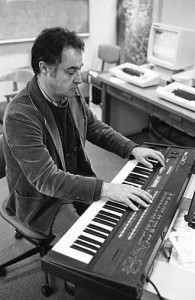
Changing the sound of music
John Chowning is a key figure in the history of digital music. His discoveries as a scientific researcher changed the way music is created and listened to. In particular, his discovery of an expressive technique for digital synthesis using frequency modulation (FM) was licensed to Yamaha, whose DX7 synthesizer defined the sound of popular music in the 1980s. As a composer, Chowning created seminal computer-music works that continue to influence and inspire. On May 21 at 7:30 p.m., the Schulich School of Music’s Centre for Interdisciplinary Research in Music Media and Technology (CIRMMT) will hold a free concert of works of computer synthesis by Chowning, Professor of Music, Emeritus at Stanford University’s Center for Computer Research in Music and Acoustics (CCRMA). Seating is limited. Please reserve online in advance at: http://www.cirmmt.mcgill.ca/
activities/live-cirmmt/reservations
Q: What gave you the idea, back in the 1960s, of using computers to synthesize sounds?
I began graduate study at Stanford University in 1962 after having studied composition for three years in Paris, where I had heard many concerts of new music including works created electroacoustically. Making music electronically from the elemental material of sound, much as a painter creates a picture – line, intensity, tone, texture, etc. – from primary colours, was a very appealing idea to me. However, Stanford had no studio for producing music electronically. Then in early 1964, I happened to read the now-
famous article that Max Mathews published in the journal Science in which he describes the research he was pursuing at Bell Telephone Laboratories synthesizing sound using digital computers. Mathews is a visionary and he provided the programs that allowed me to do the same at Stanford. I had found my medium, one that I soon discovered was far richer than any other technology.
A number of U.S. makers of electronic organs and analog synthesizers turned down your digital technology, yet Yamaha quickly bought into it. Why?
In the early 1970s, all of the other manufactures were locked into the analog domain and were unable to understand the idea of digital sound synthesis. Yamaha alone recognized that the future of technology was in the rapidly developing digital domain and had already begun basic research in the digital synthesis of sound. However, their engineers saw that there would be many years before integrated circuits would be sufficiently large in scale to allow cost-effective production of musical instruments. The problems were costs of computation and memory and a technical problem, “aliasing,” which required high sampling rates. Frequency modulation (FM) synthesis, which I discovered in 1967, was an elegant solution to these problems.
We’ve heard that your patent was at one time the most lucrative of all the patents licensed by Stanford University. Were you surprised by its commercial success?
For a few years the FM license to Yamaha was Stanford’s most productive. We were able to build an endowment for CCRMA. The gene-splicing patents finally superseded it – by orders of magnitude.
I was not surprised at the success of FM synthesis, as I understood the technology well enough to see its broad application. Everyone was surprised, however, at the success of the DX7. It was not like any existent synthesizer in many regards, but most importantly the FM technology required an entirely new vocabulary to describe sound synthesis – operators, Bessel functions, side bands, carrier and modulating frequencies – that few users understood. But it was fully transparent and programmable, so most users modified factory voices with often surprising results.
Which artists produced the best synthesizer music, in your view? Do you have a favourite recording?
Of the popular music I was not so much aware of the groups that made use of the FM technology other than a few whose performers I had met in the early days to discuss the technical aspects, for example TOTO (and their tune Africa, the first use that I heard by a big-name group) and Tangerine Dream. I later heard the use of FM synthesis by Tina Turner, Whitney Huston, Genesis, Casiopea, etc. Hey, they all sound good to me!
